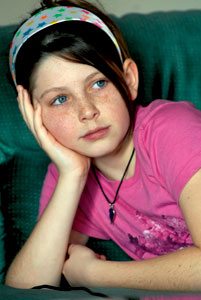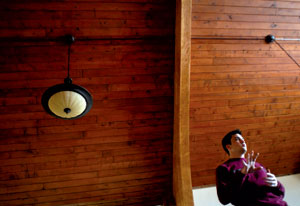SOMERS – Last August Jeff Pernell sat down with parents and told them why the Flathead Valley Montessori Academy was not financially capable of continuing.
Now he’s sitting down with them and trying to plan a language immersion session in Costa Rica for the students.
The FVMA has weathered its financial difficulties with the help of community members and, mostly, parents who wanted to have the Montessori available for their kids. Today the church-turned-school north of Somers has classes every day and recently sent a team of students to the regional Future City engineering competition in Seattle where it finished second.
“It worked out,” Pernell said, “and it is working out.”
Montessori education is growing throughout the United States and Montana. The Flathead is no different, though it has had a strong Montessori base for years. In fact, the Kalispell Montessori Center has a waiting list and works in cooperation with FVMA. Those two Montessori schools also work with Woodland Montessori to form a sister-school system.
Whereas the Woodland and Kalispell Montessori schools target preschool and elementary levels, FVMA is focusing on middle school and high school demographics, which is very rare in Montessori education. No other Montessori in the state, according to head instructor Stephanie Pernell, is available to sixth grade and above. Stephanie is getting her Montessori teaching certification at a center in Houston, the only place in the nation to certify for middle school and above education.
Montessori schools offer an alternative to mainstream education models, whether private or public. At FVMA, students help shape their own curriculums, cook their own lunches, gather in reflection sessions everyday and delve into the “powers” and “forces” of their subject matter. Also, students between 10 and 15 years old, and in the future up to 18 years old, intermingle and learn together, harkening back to the one-room schoolhouse days. They learn life skills like doing laundry, balancing a checkbook and cooking.
To be sure, students study material according to their age level, but not with walls separating them from kids of other ages. There are no desks, just comfortable couches, chairs and tables. Subjects often meld into each other, forming more of a unified learning experience.
 |
|
Casey Zanni listens as classmates ask questions during a PowerPoint presentation for class at Flathead Valley Montessori Academy. |
“You must integrate subject areas,” Stephanie said. “You can’t separate. The only time they’re going to learn is if we make connections.”
The Pernells bought St. Catherine’s Church in Bigfork two years ago, moved it north of Somers, renovated it and turned it into what is today the Montessori. Jeff said he underestimated construction costs and after taking a look at his accounting decided the Montessori couldn’t continue. That was August. Immediately, he said, parents and the community stepped up.
“We were looking at, ‘Gosh, we’re going to lose our dream,’” Jeff said.
At FVMA, curriculum is divided into three main categories: social, personal and natural. Within those three categories are five subcategories consisting of forces, structure, power, changes and balance. The most glaring diversion from mainstream education is the emphasis on personal. Students are encouraged to share personal reflections, thoughts on the day and ideas from the classroom.
“What we miss out on in traditional education is the personal,” Stephanie said. “There’s a lot of changes going on in those guys.”
The Pernells face challenges in their efforts to build a Montessori middle school and high school. For example, if students want to participate in sports like football or basketball, they have to go to public school. Also, the Pernells are battling Montessori tradition and stereotypes.
From its inception, Montessori education has focused primarily on young kids. As of now, FVMA has only six students 10 and older, though a section of the building is buzzing with more than a dozen preschool kids from Woodland Montessori. But as Montessori schools have become more prominent, many are adapting, which includes providing an education that can carry a student from preschool through high school graduation. As more people become aware that Montessori can extend past sixth grade, Stephanie believes many more students will attend FVMA.
 |
|
Jeff Pernell, a teacher and administrator at Flathead Valley Montessori Academy, describes some of the benefits he sees in the Montessori school’s structure. |
“It’s just keeping our school okay until that happens,” she said.
The Pernells each have master’s degrees and have taught for years in the public school system. But Jeff believes the mainstream system is failing to keep up with modern times. At FVMA, students are encouraged to bring their own laptops, and if they don’t have one the school provides it. The Internet is emphasized.
“Our library isn’t that huge,” Jeff said, pointing to a tall, single bookshelf, “but when you have the Internet at your fingertips it doesn’t really matter.”
Jeff was one of the first sixth-grade graduates from the Kalispell Montessori Center when the school started up in the 1980s. He went on to Flathead High School, the University of Montana and ultimately the University of Nevada-Las Vegas for his master’s in educational technology, but he never forgot his Montessori roots. He compares the principles of Montessori to college, where students are granted freedom of choice in their classes.
Shawn Stipe’s son Ryan attends FVMA. Shawn said he was originally “really leery” of Montessori when Ryan’s mother proposed the idea. But Ryan was struggling in public school and needed something new, so Shawn went along.
“It’s been great,” Shawn said. “It’s the encouragement to develop his needs in the environment he needs. I don’t regret it at all.”